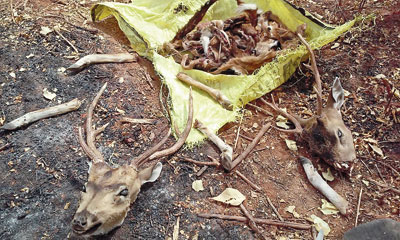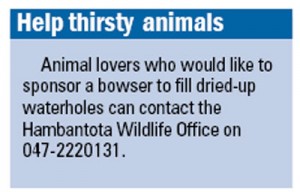News
Wildlife desperate for water

Poachers are heavily active during the drought - Hambantota
As the drought worsens, not only humans but wild animals too are suffering, reports Malaka Rodrigo
A family living in Hathporuwa, Sooriyawewa, had an unexpected visitor early morning on September 20 – an eight-foot crocodile. The family alerted Hambantota wildlife rangers who promptly responded. Later the same day, the same team of rangers had to rescue another croc, a 9.5 footer, from an agro well in Meegahajadura. As the smaller water holes dry up, wild animals looking for water are increasingly straying into human settlements.
Hambantota wildlife rangers also revealed an increase in elephants infiltrating villages and raiding crops as the drought progresses. Most of the small tanks in the pockets of forest patches had dried out so animals – particularly elephants – were moving to the remaining water sources such as Bandagiriya Wewa.
These, however, are now surrounded by cultivations, most established illegally, so the elephants now have to move through villages to get to the water, intensifying the chance of human-elephant conflict.
The dry period is a merry time for poachers. They use inhumane methods such as poisoning the remaining waterholes, bringing death to the unsuspecting animals.
The wildlife rangers and Special Task Force police nabbed three poachers at Kadawara Wewa in Hambantota this week, finding the bodies of two spotted deer they had killed. They also found different kinds of traps set up near the waterhole to capture wildlife – mainly deer.
Deer and other small animals have other new threats. As safe waterholes dry up they have to venture into more open areas. Groups of feral dogs learn to hunt these weakened animals. Hambantota wildlife officers this week found a dead deer that had been attacked by feral dogs.
The media officer of the Department of Wildlife Conservation (DWC), Hasini Sarathchandra, said the department was arranging more patrols in protected areas during this dry period but with a large pockets of unprotected areas outside national parks and only a few dozen wildlife rangers available for deployment it was impractical to expect matters to improve as the drought continued. Not only Yala, near Hambantota, but also Wilpattu and Kumana are experiencing drought.
Yala National Parks Warden D.P. Siyasinghe said this is the typical dry period Yala experiences every year. “Many of the small water pools have gone dry but there are number of large tanks and rock pools that still contain water. The department is also putting water into some of the waterholes and, with the use of solar power, some waterholes get water pumped from the river that still has water,” he said.
The Sunday Times learned that the DWC with support from Linea Aqua, last year rehabilitated a number of tanks inside Yala that helped to increase water capacity and retention so that rainwater is held for a longer period.
Some wildlife experts are of the view that drought is a natural process and we should not interfere too much with it. Late Childers Jayawardene, who was Yala Park warden in the late ’70s, earlier said “drought is nature’s way of maintaining life”.
“Drought eliminates the sick and weak animals. Next year, after the drought, what we have is a healthier animal population. Drought is nature’s way of maintaining life,” Mr. Jayawardene said. Hence mechanisms to minimise the damage from drought should be carefully considered.
Elephant expert Dr. Prithviraj Fernando pointed out that food was a bigger concern than water during a drought. An average elephant spends 16-18 hours a day grazing as it requires about 150kg of food, so a dry period is a testing time for elephants particularly restricted into a smaller area.
Dr. Fernando pointed out that many of the national parks have more elephants than their vegetation can support during drier period, so it is important that animals be able to roam in adjacent forests to assuage their hunger. As the national parks are surrounded by electric fences, however, the elephants’ movements were restricted.
“Sadly some of these fences erected between national parks and wildernesses belong to the Forest Department. It is important these fences be readjusted if we need to have a healthy elephant population in national parks such as Yala and Udawalawe,” he advised.
Dr. Fernando also said the plan to keep the Minneriya tank at spill level throughout the year for irrigation should be reconsidered in order to manage habitats for elephants in drier periods.
Hundreds of elephants in the area gather during the dry season around the Minneriya tank bed to feed on fresh shoot of grasses that come up as the water level recedes. If the Minneriya tank was at spill level all year round a large amount of these grasslands that emerge during the dry season will be submerged, depriving elephants of this nutrition-rich fodder.
Without this fresh source of food during drought, conflict will increase, Dr. Fernandp warned, urging authorities to rethink the strategy.

